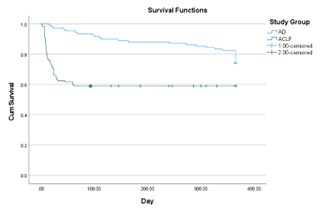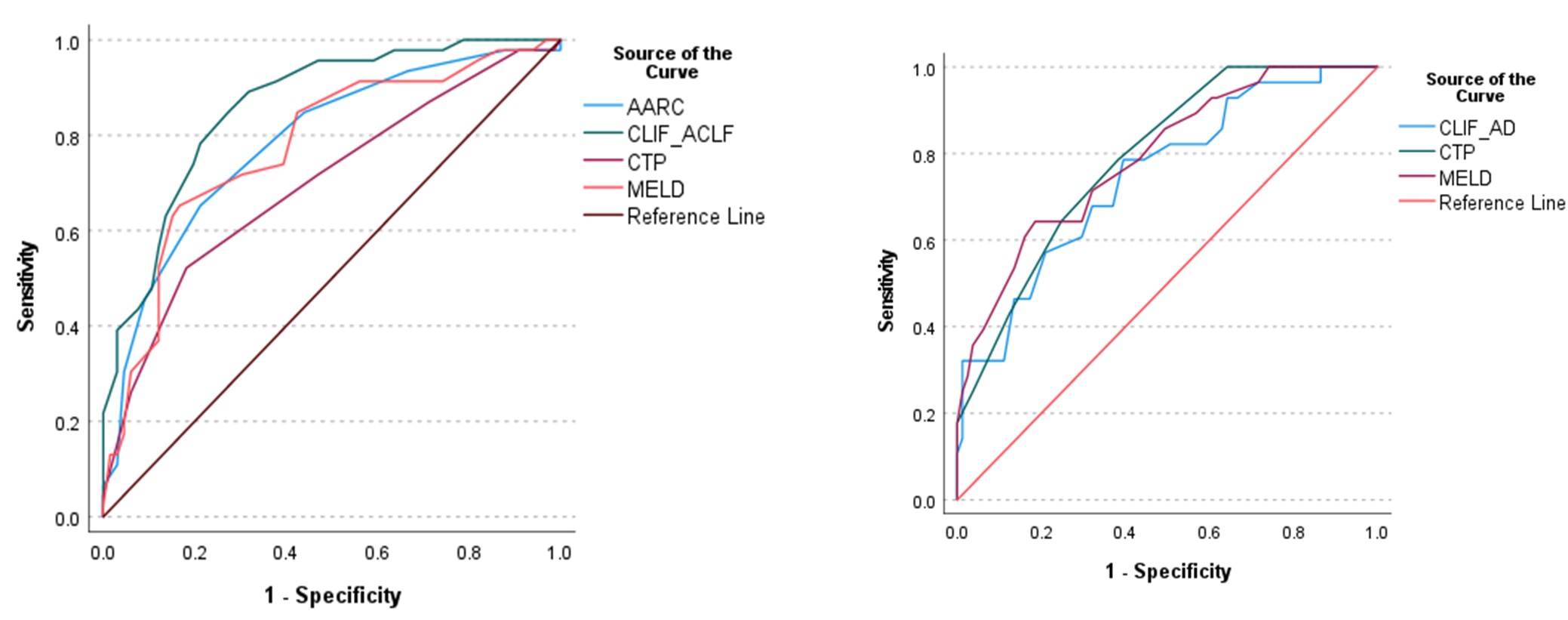Tuesday Poster Session
Category: Liver
P5901 - Long-Term Outcomes in Patients With Acute-on-Chronic Liver Failure Compared to Acute Decompensation of Cirrhosis
Tuesday, October 28, 2025
10:30 AM - 4:00 PM PDT
Location: Exhibit Hall

Dronamraju Sujay Prabhath, MBBS, MD (he/him/his)
Kasturba Medical College of Manipal
Guntur, Andhra Pradesh, India
Presenting Author(s)
Dronamraju Sujay Prabhath, MBBS, MD1, Ganesh Bhat, DM2, Shetty Aathish, MBBS, MD, DM2
1Kasturba Medical College of Manipal, Guntur, Andhra Pradesh, India; 2Kasturba Medical College of Manipal, Manipal, Karnataka, India
Introduction: Acute On Chronic Liver Failure (ACLF) is distinct clinical entity with high short-term mortality. Compared ACLF, acute decompensation of cirrhosis (AD) carries relatively lower short-term mortality due to less severe insult. Even though short-term mortality of these two conditions well documented, comparison of long-term outcome among these two conditions still not well established. Therefore, we did a retrospective observational study to compare long-term outcome of ACLF patients with AD as well as to identify the factors associated with unfavourable outcome.
Methods: In this retrospective cohort study, we included 112 ACLF patients according to APASL criteria and 109 AD patients. Data collected included demographics, disease etiology, complications, blood counts, liver and renal function tests, serum lactate, hospital admissions, and mortality
Results: Among 221 patients, majority were male (87.8 %) with a median age of 50 and alcohol was the most common etiology (50.7 %). Upper GI bleed was the leading event in the AD group (67.2 %, P < 0.001). One-year mortality was significantly higher in ACLF (41 %, P < 0.001) than AD (11 %, P < 0.001). Estimated mean survival was 326.94 days (+/- 9.24) for AD and 222.36 days (+/- 16.16, P < 0.001) for ACLF.
In ACLF, the AARC grade-III subgroup had a lower mean survival (51.22 days) than grade-II (246.21 days), a significant difference (P < 0.001). Patients with CLIF-AD scores > 60 had a mean survival of 293.11 days, slightly lower than 349.1 days for those scoring below 60. While the ACLF group had highest short term (30 days, 36.6 %), mortality in AD was highest between 91-365 days.
The area under the curve (AUC) for CLIF-ACLF > 48.5 was 86 % (sensitivity 84.8 %, specificity 72.7 %), and for CTP score > 12.5 was 69.6 % (sensitivity 52.2 %, specificity 81.8 %). CLIF-ACLF demonstrated superior prognostic discrimination compared to CTP (p = 0.005).
Among AD patients, CTP, MELD and CLIFF-AD scores were similar in predicting long term outcomes. In ACLF patients AARC and ACLF-CLIFF scores showed trend towards better performance predicting the long-term outcomes.
Discussion: Alcohol is emerging as major etiology in both the group. Even though ACLF carries high short-term mortality, their long-term survival is slightly better than AD. Existing scores are not helpful in predicting long term outcome among ACLF patients, stressing the need for better score for these group of patients

Figure: Figure 1: Kaplan-Meier Survival Curve for AD and ACLF Groups

Figure: Figure 2A and 2B: Receiver Operating Characteristic (ROC) Curve for AARC, CLIF-ACLF, CTP, MELD in ACLF (2A) and CTP, MELD and CLIF-AD in AD (2B)
Disclosures:
Dronamraju Sujay Prabhath indicated no relevant financial relationships.
Ganesh Bhat indicated no relevant financial relationships.
Shetty Aathish indicated no relevant financial relationships.
Dronamraju Sujay Prabhath, MBBS, MD1, Ganesh Bhat, DM2, Shetty Aathish, MBBS, MD, DM2. P5901 - Long-Term Outcomes in Patients With Acute-on-Chronic Liver Failure Compared to Acute Decompensation of Cirrhosis, ACG 2025 Annual Scientific Meeting Abstracts. Phoenix, AZ: American College of Gastroenterology.
1Kasturba Medical College of Manipal, Guntur, Andhra Pradesh, India; 2Kasturba Medical College of Manipal, Manipal, Karnataka, India
Introduction: Acute On Chronic Liver Failure (ACLF) is distinct clinical entity with high short-term mortality. Compared ACLF, acute decompensation of cirrhosis (AD) carries relatively lower short-term mortality due to less severe insult. Even though short-term mortality of these two conditions well documented, comparison of long-term outcome among these two conditions still not well established. Therefore, we did a retrospective observational study to compare long-term outcome of ACLF patients with AD as well as to identify the factors associated with unfavourable outcome.
Methods: In this retrospective cohort study, we included 112 ACLF patients according to APASL criteria and 109 AD patients. Data collected included demographics, disease etiology, complications, blood counts, liver and renal function tests, serum lactate, hospital admissions, and mortality
Results: Among 221 patients, majority were male (87.8 %) with a median age of 50 and alcohol was the most common etiology (50.7 %). Upper GI bleed was the leading event in the AD group (67.2 %, P < 0.001). One-year mortality was significantly higher in ACLF (41 %, P < 0.001) than AD (11 %, P < 0.001). Estimated mean survival was 326.94 days (+/- 9.24) for AD and 222.36 days (+/- 16.16, P < 0.001) for ACLF.
In ACLF, the AARC grade-III subgroup had a lower mean survival (51.22 days) than grade-II (246.21 days), a significant difference (P < 0.001). Patients with CLIF-AD scores > 60 had a mean survival of 293.11 days, slightly lower than 349.1 days for those scoring below 60. While the ACLF group had highest short term (30 days, 36.6 %), mortality in AD was highest between 91-365 days.
The area under the curve (AUC) for CLIF-ACLF > 48.5 was 86 % (sensitivity 84.8 %, specificity 72.7 %), and for CTP score > 12.5 was 69.6 % (sensitivity 52.2 %, specificity 81.8 %). CLIF-ACLF demonstrated superior prognostic discrimination compared to CTP (p = 0.005).
Among AD patients, CTP, MELD and CLIFF-AD scores were similar in predicting long term outcomes. In ACLF patients AARC and ACLF-CLIFF scores showed trend towards better performance predicting the long-term outcomes.
Discussion: Alcohol is emerging as major etiology in both the group. Even though ACLF carries high short-term mortality, their long-term survival is slightly better than AD. Existing scores are not helpful in predicting long term outcome among ACLF patients, stressing the need for better score for these group of patients

Figure: Figure 1: Kaplan-Meier Survival Curve for AD and ACLF Groups

Figure: Figure 2A and 2B: Receiver Operating Characteristic (ROC) Curve for AARC, CLIF-ACLF, CTP, MELD in ACLF (2A) and CTP, MELD and CLIF-AD in AD (2B)
Disclosures:
Dronamraju Sujay Prabhath indicated no relevant financial relationships.
Ganesh Bhat indicated no relevant financial relationships.
Shetty Aathish indicated no relevant financial relationships.
Dronamraju Sujay Prabhath, MBBS, MD1, Ganesh Bhat, DM2, Shetty Aathish, MBBS, MD, DM2. P5901 - Long-Term Outcomes in Patients With Acute-on-Chronic Liver Failure Compared to Acute Decompensation of Cirrhosis, ACG 2025 Annual Scientific Meeting Abstracts. Phoenix, AZ: American College of Gastroenterology.
